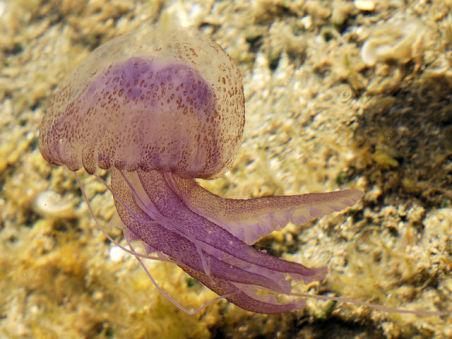The French Riviera is seeing increasing numbers of the mauve stinger
jellyfish, despite such precautions as jellyfish nets, making it to the beaches. As many as 500
bathers a day are getting stung by the tentacled menace, and scientists
are warning that this year could be worse than ever as the jellyfish
population explodes. A sort of jellyfish early warning system will now allow tourists to avoid them.  Mauve Stinger Jellyfish
Mauve Stinger Jellyfish
The over-population of jellyfish along Mediterranean coastal waters (among others worldwide) is being blamed on a combination of global warming and over-fishing. The warmer waters have given way to a rise in the levels of the plankton on which they feed, and over-fishing has reduced the numbers of their natural predators, like tuna and sea turtles. The rising numbers of jellyfish in the oceans worldwide has created concerns over "jellification" of the seas.
Researchers have discovered a link between wind and water currents and the beaching of jellyfish. They normally live in the open sea, but they rise to the surface at night when changes in water and air currents can carry them into the shallows to be washed up onto the beaches. Understanding these conditions has helped predict the likelihood of a "smack" of jellyfish causing a problem for tourists along the Riviera. The forecasts are made up to 48 hours in advance. The alert consists of a five point scale, ranging from one, or minimal risk, to five, or maximum risk.
The sting of the mauve stinger jellyfish comes from contact with one of its hair-like tentacles that can grow up to three feet in length. The nettle-like burns can be extremely painful and take three days to heal. The stings can also trigger anaphylactic reactions such as asthma and other allergic attacks. In some rare cases a sting can lead to death due to cardiac arrest.
The mauve stinger jellyfish is found in most tropical and temperate ocean waters of the world, including along some coastal areas of the U.S. While many treatments for jellyfish stings abound, from urine to baking soda, scientists say that many of the studies that have suggested these methods were done in places like Australia and Indonesia. For stings along the coasts of North America, the best treatment is hot water and topical pain relievers.
Sources: The Telegraph (1), The Telegraph (2)

